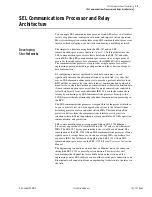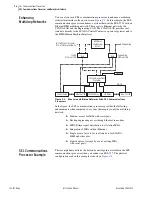
10.11
Date Code 20081022
Instruction Manual
SEL-787 Relay
Testing and Troubleshooting
Periodic Tests (Routine Maintenance)
Periodic Tests (Routine Maintenance)
Because the SEL-787 is equipped with extensive self-tests, the most effective
maintenance task is to monitor the front-panel messages after a self-test
failure. In addition, each relay event report generated by a fault should be
reviewed. Such reviews frequently reveal problems with equipment external to
the relay, such as instrument transformers and control wiring.
The SEL-787 does not require specific routine tests, but your operation
standards may require some degree of periodic relay verification. If you need
or want to perform periodic relay verification, the following checks are
recommended.
Self-Test
The SEL-787 runs a variety of self-tests. Two Relay Word bits, HALARM and
SALARM, signal self-test problems. SALARM is pulsed for software-
programmed conditions, such as settings changes, access level changes, and
three consecutive unsuccessful password entry attempts. HALARM is pulsed
for hardware self-test warnings. HALARM is continuously asserted (set to
logical 1) for hardware self-test failures. A diagnostic alarm may be
configured as explained in
Section 4: Protection and Logic Functions
.
lists hardware self-tests. In the Alarm Status column, Latched
indicates that HALARM is continuously asserted, Not Latched indicates that
HALARM is pulsed for five seconds, and NA indicates that HALARM is not
asserted.
All hardware self-test failures generate a front-panel message that is
automatically sent to the serial port. All hardware self-test failures (Latched
entry in Alarm Status column) disable the relay.
Table 10.7
Periodic Relay Checks
Test
Description
Relay Status
Use the front-panel
STATUS
or serial port
STATUS
command to
verify that the relay self-tests have not detected any WARN or FAIL
conditions.
Meter
Verify that the relay is correctly measuring current and voltage (if
included) by comparing the relay meter readings to separate external
meters.
Control Input
Using the front-panel
MAIN > Targets > Row 21
function,
check the control input status in the relay. As you apply rated voltage
to each input, the position in Row 21 corresponding to that input
should change from zero (0) to one (1).
Contact Output
For each output contact, set the input to Logic 1. This causes the output
contact to close. For example, setting OUT101 := 1 causes the output
OUT101
contact to close.
Repeat the process for all contact outputs. Make sure that each contact
closure does what you want it to do in the annunciation, control, or trip
circuit associated with that contact closure.
Summary of Contents for SEL-787
Page 1: ...20081022 SEL 787 Transformer Protection Relay Instruction Manual PM787 01 NB ...
Page 6: ...This page intentionally left blank ...
Page 12: ...This page intentionally left blank ...
Page 18: ...This page intentionally left blank ...
Page 78: ...This page intentionally left blank ...
Page 206: ...This page intentionally left blank ...
Page 280: ...This page intentionally left blank ...
Page 334: ...This page intentionally left blank ...
Page 376: ...This page intentionally left blank ...
Page 388: ...This page intentionally left blank ...
Page 474: ...This page intentionally left blank ...
Page 508: ...This page intentionally left blank ...
















































